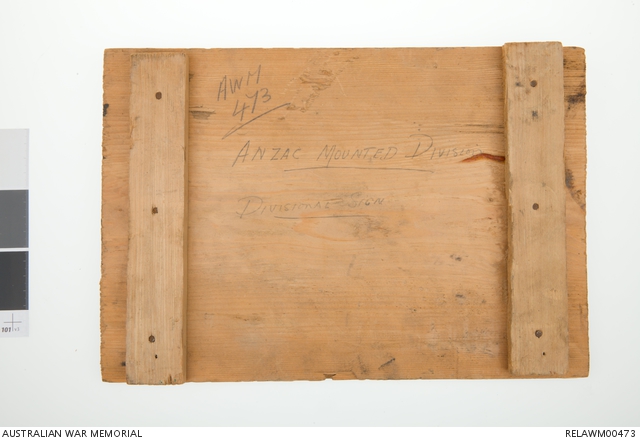| Places | |
|---|---|
| Accession Number | RELAWM00473 |
| Collection type | Heraldry |
| Object type | Heraldry |
| Physical description | Wood |
| Location | Main Bld: First World War Gallery: Sinai Palestine 1917: The Light Horse Men |
| Maker |
Unknown |
| Date made | c 1916-1918 |
| Conflict |
First World War, 1914-1918 |
Boomerang and fern leaf sign : ANZAC Mounted Division


Black painted wooden sign with the symbol of the ANZAC Mounted Division painted on it in white. The symbol is a boomerang and a silver fern frond entwined, the boomerang being laid over the fern on the left and under it on the right. There are two vertical wooden crossmembers nailed to the reverse of the sign.
The ANZAC Mounted Division was formed in Egypt in April 1916 by joining the New Zealand Mounted Rifle Brigade and 1, 2 and 3 Australian Light Horse Brigades, under the command of (then) Major General HG Chauvel. Command passed to Major General EWC Chaytor in 1917. The main units involved in the formation of ANZAC Mounted were: the Wellington, Auckland and Canterbury Mounted Rifles and the 1st, 2nd, 3rd, 5th, 6th, 7th, 8th, 9th and 10th Australian Light Horse Regiments. 1, 2 and 3 Australian Machine Gun Squadrons, and 1 NZ Machine Gun Squadron also formed a part of the mounted force. Initially, 4 Australian Light Horse Brigade (4, 11 and 12 ALH Regts) was also split between the other brigades and attached to the division. In this form, the ANZAC Mounted Division fought at Romani, and in the advance through Sinai to the border of Palestine.
In January 1917, a reorganisation saw 3 ALH Brigade (7, 8 and 10 ALH Regts and 3 Aust MG Sqn) withdrawn to form part of the newly created Imperial (later Australian) Mounted Division. At the same time, 4 ALH Brigade was reunited as part of the same formation. The ANZAC and the Australian Mounted Divisions, together with the (British) Yeomanry Division made up the Desert Mounted Corps, which went on to completely defeat the Turkish forces in Palestine.
The Anzac Mounted Division sign makes use of the New Zealand fern and the Australian boomerang to reflect the make up of the division. This sign was collected by teh Australian War Records Section in 1918.